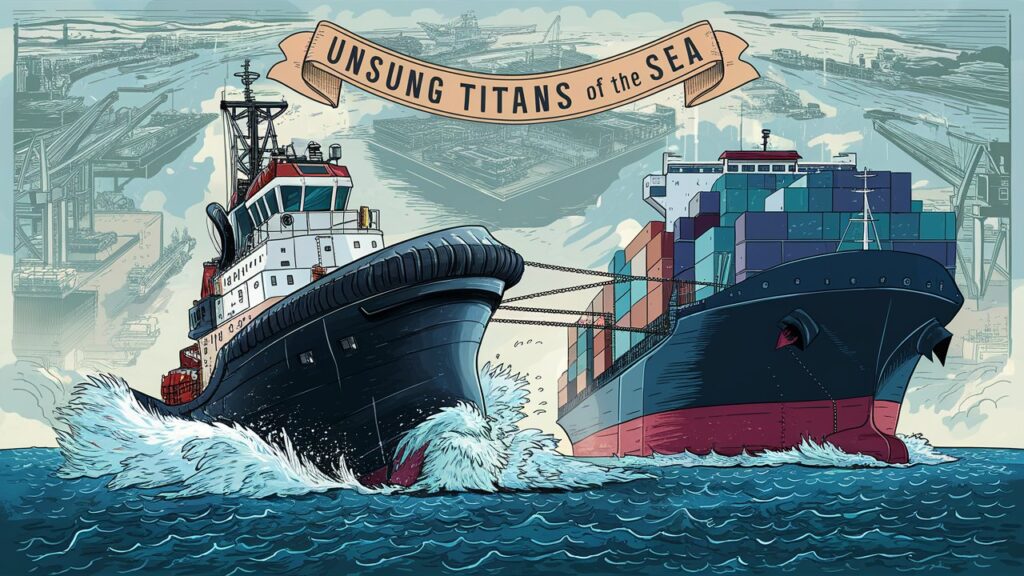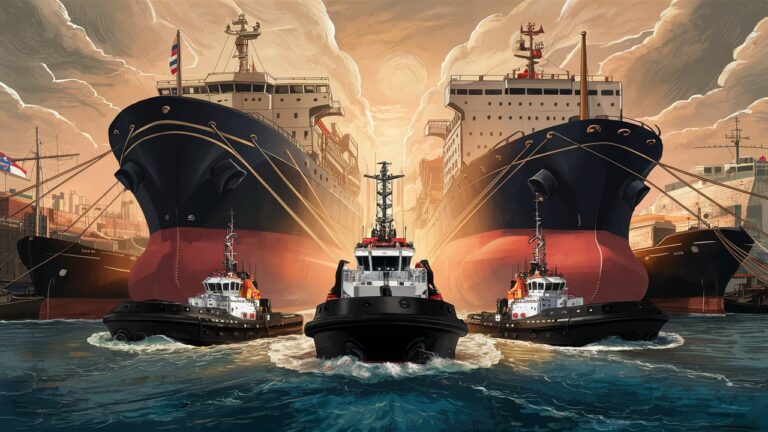Introduction
In the intricate ballet of global maritime operations, towage companies emerge as the indispensable choreographers, orchestrating the safe and efficient movement of vessels through the world’s most congested waterways. These specialized firms deploy powerful tugboats and seasoned crews to maneuver massive cargo ships, tankers, and luxury liners in ports, narrow channels, and open oceans. Without their expertise, modern shipping—responsible for 90% of global trade—would grind to a halt, risking supply chain chaos, environmental disasters, and economic paralysis. This article delves into the critical functions, technological innovations, and strategic value of towage services, revealing why these companies are the silent guardians of maritime safety and efficiency.
1. Defining Towage Services: The Core Mission
Towage services encompass the specialized assistance provided to vessels that lack the maneuverability to navigate confined or hazardous areas independently. Unlike conventional shipping, towage companies focus on short-distance operations where precision, power, and local expertise are paramount. Tugboats act as “marine bulldozers,” using controlled force to push, pull, or stabilize ships during high-stakes operations like docking in gale-force winds or extracting grounded tankers from sandbanks. The sector’s backbone is its ability to prevent collisions, groundings, and oil spills—mitigating risks that could escalate into multimillion-dollar liabilities.
2. Harbor Towing: Mastering Port Dynamics
Harbor towing represents the most visible facet of towage, where tugboats guide vessels through crowded ports and intricate docking sequences. In hubs like Singapore or Rotterdam, tugs perform “ship handling”—a complex dance where azimuth stern drive (ASD) tugboats rotate 360 degrees to nudge megaships against currents or winds. Operators rely on real-time data from port authorities, adjusting thrust to counteract variables like tidal swings or vessel draft. The precision required is staggering: a single misstep could rupture hulls, damage infrastructure, or trigger cargo delays cascading through supply chains.
3. Ocean Towing: Long-Haul Heavy Lifting
When massive oil platforms, decommissioned warships, or floating dry docks require relocation across oceans, ocean towing takes center stage. Here, ultra-powerful anchor-handling tugs (AHTs) connect to cargo via steel cables or synthetic ropes, enduring weeks of open-sea challenges like rogue waves or equipment fatigue. Companies meticulously plan routes using meteorological AI to avoid storms, while engineers monitor hull stress remotely. This high-risk service demands vessels with 10,000+ horsepower and crews trained in salvage law—a niche where failure could mean losing multimillion-dollar assets to the depths.
4. Escort Towing: The Environmental Safeguard
Escort towing is the maritime industry’s insurance policy against ecological catastrophe. In environmentally sensitive zones like Alaska’s Prince William Sound, tugboats trail laden tankers, ready to arrest momentum within seconds if engines fail. Using Voith Schneider Propellers (VSP)—rotors that generate instant directional thrust—these tugs can “grab” a 200,000-ton vessel barreling toward rocks. Regulatory bodies increasingly mandate such services; for instance, the EU requires escort towing for single-hull oil tankers, recognizing its role in preventing spills like the Exxon Valdez.

5. Ship Docking and Undocking: Precision Under Pressure
Docking and undocking operations epitomize the tug captain’s artistry. As a container ship approaches a quay, tugs position themselves at “push points” (bow/stern quarters) to counteract inertia. Factors like bank effect (water displacement near shores) or propeller wash complicate maneuvers. Captains use a combination of direct towing, indirect “breasting” (pushing sideways), and computerized tension monitoring to inch vessels into place. Post-pandemic port congestion has amplified demand for these services, with delays costing carriers $20,000/hour—making tug efficiency a direct economic lever.
6. Salvage Operations: Crisis as a Core Competency
When vessels founder, towage companies transform into first responders. Salvage operations blend engineering ingenuity with emergency tactics: refloating ships using airbags and buoyancy calculations, patching hull breaches with underwater welding, or preventing oil leaks via containment booms. Firms like Smit Salvage (a division of Boskalis) maintain global response fleets equipped with firefighting systems and dynamic positioning technology. Success hinges on speed—the “golden 12-hour window” after an incident—to stabilize wrecks before storms or tides escalate damage.
7. Fleet Technology: The Rise of Smart Tugboats
Modern towage fleets integrate cutting-edge tech to amplify human skill. Azimuth Stern Drive (ASD) tugboats dominate harbors for their agility, while Voith Schneider Propellers (VSP) excel in escort roles for their thrust precision. Digital twin simulations train crews for crisis scenarios, and IoT sensors predict mechanical failures before they strand tugs mid-operation. Sustainability pressures drive hybrid-electric innovations, like the world’s first zero-emission tug, the “Sparky,” operating in New Zealand—signaling an industry-wide pivot toward decarbonization.
8. Economic Impact: Enabling Trade Resilience
Towage companies are economic force multipliers. By slashing port turnaround times by 30%, they accelerate cargo flows in megaports like Shanghai, where a single day’s delay can backlog hundreds of ships. During the 2021 Suez Canal blockage, Egyptian tugs like the Baraka 1 became global heroes for dislodging the Ever Given—averting a $10 billion/week trade disruption. The industry also creates high-skill jobs: from naval architects designing bollard-pull-optimized hulls to maritime lawyers negotiating salvage contracts under Lloyd’s Open Form agreements.
Conclusion
Towage companies operate at the nerve center of maritime safety and efficiency, blending human expertise with technological innovation to keep global trade arteries flowing. As shipping volumes soar and environmental regulations tighten, their role evolves from auxiliary service to strategic partner—investing in AI-driven tugs, green propulsion, and disaster-ready salvage fleets. In an era of climate volatility and supply chain fragility, these unsung titans not only protect coasts and cargo but also underpin the resilient movement of goods upon which modern civilization depends.
Frequently Asked Questions (FAQs)
Q1: What’s the difference between harbor towing and ocean towing?
Harbor towing involves short-distance maneuvers within ports, channels, or rivers, using agile tugboats for docking/undocking. Ocean towing covers long-haul transport of non-powered structures (e.g., oil rigs, barges) across open seas, requiring larger vessels with enhanced fuel capacity and seakeeping stability.
Q2: Why do massive ships need tiny tugs?
Tugboats generate disproportionate power via propulsion systems like ASD or VSP, allowing precise force application. A 30-meter tug can pivot a 300-meter ship because it acts as a lever—applying thrust at critical points (e.g., the bow) to overcome inertia.
Q3: How do towage companies prevent environmental damage?
Through escort towing protocols, oil-spill response teams, and vessel designs minimizing emissions. Advanced tugs feature double-hulls for fuel containment, while AI route planning reduces collision risks near ecologically sensitive areas.
Q4: What qualifications do tug operators require?
Captains need specialized licenses (e.g., Master of Towing Vessels), while crews train in firefighting, damage control, and dynamic positioning. Companies like Svitzer run simulation academies for crisis scenarios like hurricane rescues.
Q5: How is technology reshaping towage?
Autonomous tugs (e.g., Rolls-Royce’s Otter) are being tested for remote operations, while digital platforms like “TugOS” optimize fleet deployment using real-time port data. Hybrid propulsion cuts CO₂ emissions by 20–40%, aligning with IMO 2030 targets.
